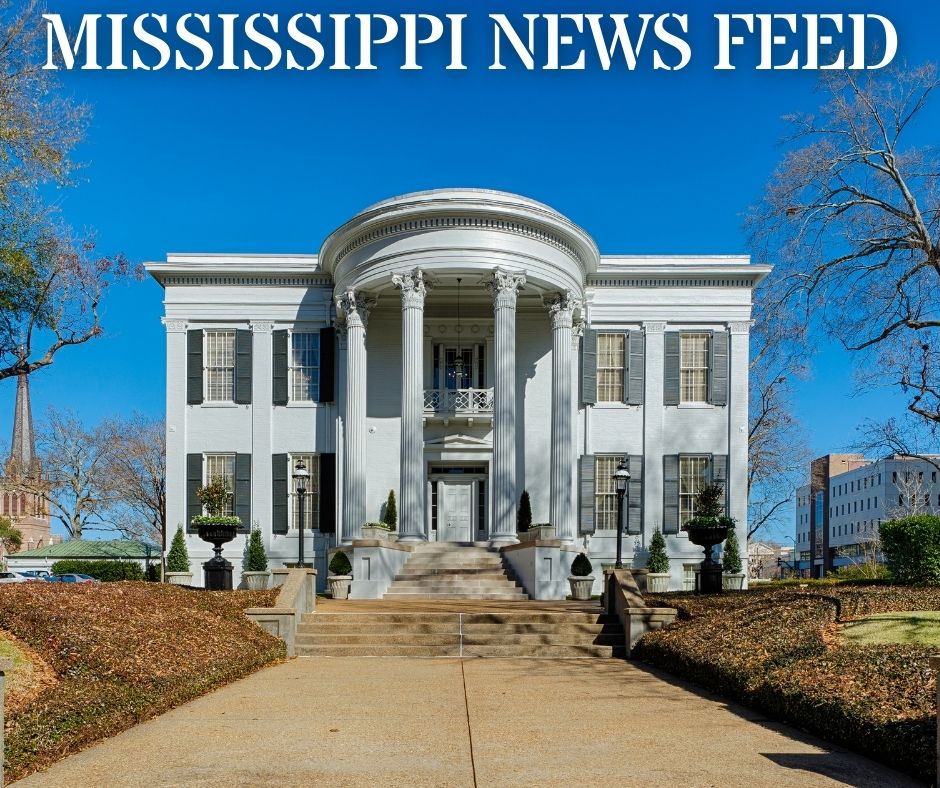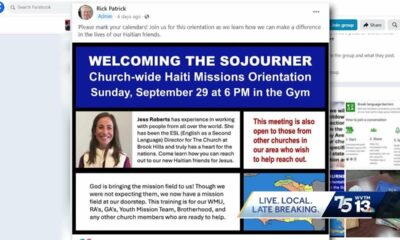Mississippi Today
Program aimed at increasing access to prenatal care pending federal approval
Pregnancy presumptive eligibility in Mississippi is still not in effect, despite becoming law July 1. However, the Division of Medicaid said it has cleared several administrative hurdles and is awaiting action from the federal government.
But a discrepancy between state and federal law may delay the process further.
Legislators wrote in the bill that pregnant women must provide proof of income when seeking prenatal care. Federal guidelines, however, state that while the agency may require proof of citizenship or residency, it should not “require verification of the conditions for presumptive eligibility.”
Matt Westerfield, spokesperson from the Division of Medicaid, said the “federal regulations could be open to multiple interpretations” and that the division doesn’t necessarily expect the discrepancy to become a problem.
“The Division can’t speak on behalf of lawmakers about what was drafted and why. But we do think the Legislature included a sensible provision that an individual seeking taxpayer-funded Medicaid benefits meet minimal requirements for presumptive eligibility,” Westerfield said.
House Medicaid Chair Missy McGee, a Republican from Hattiesburg and the author of the bill, did not respond to questions about the discrepancy by the time of publication.

House Bill 539 allows certain low-income, uninsured pregnant women to receive immediate prenatal care covered by Medicaid while they wait for their Medicaid application to be officially approved, which can take up to 45 days. The governor signed it into law in March, and it became law July 1.
Meant to tide women over in what is sometimes a “no coverage” window, the policy ensures that uninsured women receive timely prenatal care – proven to mitigate health risks like hypertension, one of the leading causes of maternal mortality in the state, according to a 2023 report by the Mississippi State Department of Health.
“I would suggest that requesting proof of income is requiring verification of the conditions for presumptive eligibility,” argued Tricia Brooks, a research professor at the Center for Children and Families at Georgetown University and the lead author on the KFF Annual Survey on Medicaid and CHIP Eligibility, Enrollment and Renewal Policies. “And I think that’s a barrier. I think it’s a barrier for individuals, and I think it’s a barrier for the provider offices.”
That’s because requiring that kind of proof can make the program less accessible for patients already facing socioeconomic hurdles, Brooks elaborated, as well as less efficient for providers.
“I remember when I first got pregnant, I thought I had the flu because I was nauseous for days on end,” Brooks said. “If I go to the doctor and find out that lo and behold maybe I am pregnant, and you want me to get enrolled, but now you’re asking me for paystubs … So now I have to come back in or somehow communicate or transmit proof of income to the provider. That just gives everybody pause of, ‘Oh my god, is this even worth it?’”
To participate in presumptive eligibility, doctors and other qualifying providers must complete an application and undergo eligibility determination training, in addition to submitting a memorandum of understanding with the agency once approved.
So far, no providers have signed up to participate, and the only information available online is a brief explainer on Medicaid’s website posted at the end of June.
But the division plans to post more information on its website “in the next week or two,” Westerfield said on July 10. So far, nothing new has been posted.
“We will also communicate the policy along with other agency updates through various meetings and conversations with provider groups we are in regular contact with,” Westerfield said last week.
Mississippi Today repeatedly requested a phone or in-person interview with an agency official involved with the rollout of presumptive eligibility, but the Division of Medicaid said it would only communicate via email.
Mississippi Today reached out to University of Mississippi Medical Center – Mississippi’s largest Medicaid provider – on July 2 and again on July 11 to determine what, if any, communication it has received about how presumptive eligibility will work.
A hospital spokesperson declined to comment both times. Ochsner Rush Hospital in Meridian and the Hattiesburg Clinic also declined to comment.
North Mississippi Medical Center in Tupelo and Merit Health Central in Jackson did not respond to Mississippi Today’s questions about what, if any, information the Division of Medicaid had sent by the time of publication.
Delta Health Center, a Federally Qualified Community Health Center in Mound Bayou, said the clinic received information about signing up from the Division of Medicaid on July 3, and the clinic plans to participate.
“Waiting for Medicaid determination has been a huge barrier to accessing early prenatal care for many of our maternal health patients,” a spokesperson from the clinic told Mississippi Today via email.
To educate the public on participating locations, Westerfield said the division will publish and continually update a list of participating providers.
He also said they will use social media to promote what doctors and clinics are participating in the program.
Applicants can potentially get same-day coverage if they know the number of people in the household and can show proof of monthly income, according to the division.
How to know if you qualify
Anyone who is pregnant and makes at or below 194% of the federal poverty level qualifies for Medicaid and for presumptive eligibility. These individuals can start receiving care as soon as they find out they’re pregnant by showing proof of monthly income to staff at a qualifying location.
While it’s not known which providers, if any, have chosen to participate so far, Mississippi Today will continue to monitor the Division of Medicaid’s implementation of the policy and report on qualifying providers as they sign up.
This article first appeared on Mississippi Today and is republished here under a Creative Commons license.
Mississippi Today
A Mississippi town moves a Confederate monument that became a shrouded eyesore
GRENADA (AP) — A Mississippi town has taken down a Confederate monument that stood on the courthouse square since 1910 — a figure that was tightly wrapped in tarps the past four years, symbolizing the community’s enduring division over how to commemorate the past.
Grenada’s first Black mayor in two decades seems determined to follow through on the city’s plans to relocate the monument to other public land. A concrete slab has already been poured behind a fire station about 3.5 miles (5.6 kilometers) from the square.
But a new fight might be developing. A Republican lawmaker from another part of Mississippi wrote to Grenada officials saying she believes the city is violating a state law that restricts the relocation of war memorials or monuments.
The Grenada City Council voted to move the monument in 2020, weeks after police killed George Floyd in Minneapolis. The vote seemed timely: Mississippi legislators had just retired the last state flag in the U.S. that prominently featured the Confederate battle emblem.
The tarps went up soon after the vote, shrouding the Confederate soldier and the pedestal he stood on. But even as people complained about the eyesore, the move was delayed by tight budgets, state bureaucracy or political foot-dragging. Explanations vary, depending on who’s asked.
A new mayor and city council took office in May, prepared to take action. On Sept. 11, with little advance notice, police blocked traffic and a work crew disassembled and removed the 20-foot (6.1-meter) stone structure.
“I’m glad to see it move to a different location,” said Robin Whitfield, an artist with a studio just off Grenada’s historic square. “This represents that something has changed.”
Still, Whitfield, who is white, said she wishes Grenada leaders had invited the community to engage in dialogue about the symbol, to bridge the gap between those who think moving it is erasing history and those who see it as a daily reminder of white supremacy. She was among the few people watching as a crane lifted parts of the monument onto a flatbed truck.
“No one ever talked about it, other than yelling on Facebook,” Whitfield said.
Mayor Charles Latham said the monument has been “quite a divisive figure” in the town of 12,300, where about 57% of residents are Black and 40% are white.
“I understand people had family and stuff to fight and die in that war, and they should be proud of their family,” Latham said. “But you’ve got to understand that there were those who were oppressed by this, by the Confederate flag on there. There’s been a lot of hate and violence perpetrated against people of color, under the color of that flag.”
The city received permission from the Mississippi Department of Archives and History to move the Confederate monument, as required. But Rep. Stacey Hobgood-Wilkes of Picayune said the fire station site is inappropriate.
“We are prepared to pursue such avenues that may be necessary to ensure that the statue is relocated to a more suitable and appropriate location,” she wrote, suggesting a Confederate cemetery closer to the courthouse square as an alternative. She said the Ladies Cemetery Association is willing to deed a parcel to the city to make it happen.
The Confederate monument in Grenada is one of hundreds in the South, most of which were dedicated during the early 20th century when groups such as the United Daughters of the Confederacy sought to shape the historical narrative by valorizing the Lost Cause mythology of the Civil War.
The monuments, many of them outside courthouses, came under fresh scrutiny after an avowed white supremacist who had posed with Confederate flags in photos posted online killed nine Black people inside the historic Emanuel African Methodist Episcopal Church in Charleston, South Carolina, in 2015.
Grenada’s monument includes images of Confederate president Jefferson Davis and a Confederate battle flag. It was engraved with praise for “the noble men who marched neath the flag of the Stars and Bars” and “the noble women of the South,” who “gave their loved ones to our country to conquer or to die for truth and right.”
A half-century after it was dedicated, the monument’s symbolism figured in a voting rights march. When the Rev. Martin Luther King Jr. and other civil rights leaders held a mass rally in downtown Grenada in June 1966, Robert Green of the Southern Christian Leadership Conference scrambled up the pedestal and planted a U.S. flag above the image of Davis.
The cemetery is a spot Latham himself had previously advocated as a new site for the monument, but he said it’s too late to change now, after the city already budgeted $60,000 for the move.
“So, who’s going to pay the city back for the $30,000 we’ve already expended to relocate this?” he said. “You should’ve showed up a year and a half ago, two years ago, before the city gets to this point.”
A few other Confederate monuments in Mississippi have been relocated. In July 2020, a Confederate soldier statue was moved from a prominent spot at the University of Mississippi to a Civil War cemetery in a secluded part of the Oxford campus. In May 2021, a Confederate monument featuring three soldiers was moved from outside the Lowndes County Courthouse in Columbus to another cemetery with Confederate soldiers.
Lori Chavis, a Grenada City Council member, said that since the monument was covered by tarps, “it’s caused nothing but more divide in our city.”
She said she supports relocating the monument but worries about a lawsuit. She acknowledged that people probably didn’t know until recently exactly where it would reappear.
“It’s tucked back in the woods, and it’s not visible from even pulling behind the fire station,” Chavis said. “And I think that’s what got some of the citizens upset.”
This article first appeared on Mississippi Today and is republished here under a Creative Commons license.
Crooked Letter Sports Podcast
Podcast: New Orleans sports columnist and author Jeff Duncan joins the podcast to talk about his new Steve Gleason book and the new-look New Orleans Saints.
Jeff Duncan went from the Mississippi Book Festival in Jackson on Saturday to Jerry World in Dallas on Sunday where he watched and wrote about the Saints’ total dismantling of the Dallas Cowboys. We talk about both events and also about what happened in high school and college football last weekend and what’s coming up this weekend.
Stream all episodes here.
This article first appeared on Mississippi Today and is republished here under a Creative Commons license.
Mississippi Today
On this day in 1899
Sept. 18, 1899

Scott Joplin, known as “the King of Ragtime,” copyrighted the “Maple Leaf Rag,” which became the first song to sell more than 1 million copies of sheet music. The popularity launched a sensation surrounding ragtime, which has been called America’s “first classical music.”
Born near Texarkana, Texas, Joplin grew up in a musical family. He worked on the railroad with other family members until he was able to earn money as a musician, traveling across the South. He wound up playing at the World’s Fair in Chicago in 1893, where he met fellow musician Otis Saunders, who encouraged him to write down the songs he had been making up to entertain audiences. In all, Joplin wrote dozens of ragtime songs.
After some success, he moved to New York City, hoping he could make a living while stretching the boundaries of music. He wrote a ragtime ballet and two operas, but success in these new forms eluded him. He was buried in a pauper’s grave in New York City in 1917.
More than six decades later, his music was rediscovered, initially by Joshua Rifkin, who recorded Joplin’s songs on a record, and then Gunther Schuller of the New England Conservatory, who performed four of the ragtime songs in concert: “My faculty, many of whom had never even heard of Joplin, were saying things like, ‘My gosh, he writes melodies like Schubert!’”
Joplin’s music won over even more admirers through the 1973 movie, “The Sting,” which won an Oscar for the music. His song, “The Entertainer,” reached No. 3 on Billboard and was ranked No. 10 among “Songs of the Century” list by the Recording Industry Association of America. His opera “Treemonisha” was produced to wide acclaim, and he won a Pulitzer Prize in 1976 for his special contribution to American music.
“The ragtime craze, the faddish thing, will obviously die down, but Joplin will have his position secure in American music history,” Rifkin said. “He is a treasurable composer.”
This article first appeared on Mississippi Today and is republished here under a Creative Commons license.
-
Mississippi News Video6 days ago
Woman arrested after reposting school threat in Calhoun County
-
News from the South - Louisiana News Feed6 days ago
Food drive underway for Hurricane Francine victims in Kenner
-
Mississippi Today3 days ago
On this day in 1925
-
News from the South - Kentucky News Feed5 days ago
The search for Joseph Couch intensifies
-
News from the South - Alabama News Feed3 days ago
Diddy Arrested In Manhattan | September 16, 2024 | News 19 at 10 p.m.
-
News from the South - Alabama News Feed5 days ago
Sylacauga Church welcomes Haitian migrants amid speculations
-
Mississippi Today3 days ago
Another Midwest drought is causing transportation headaches on the Mississippi River
-
News from the South - Florida News Feed7 days ago
Tropics update: Tropical Depression 7, 2 other disturbances brewing in Atlantic








































